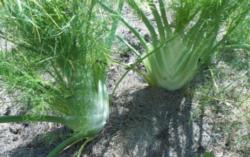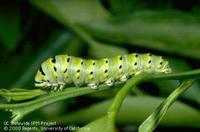Fennel
The Basics
There are two types of fennel:- Florence fennel, also called bulbing fennel: grown primarily for the bulb-like base of the stalks which is eaten as a vegetable. Leaves and seeds can also be harvested.
- Common and bronze fennel: grown just for the seeds or foliage (they do not form succulent bulbs), but are not recommended in the Bay Area due to concerns regarding invasiveness.
Overview
- Although a perennial, most fennel is grown as a cool season annual for harvesting as bulbs.
- Fennel, even bulbing fennel, will self-sow easily and can take over an area if not controlled.
- Fennel attracts many beneficial insects and is a host plant for swallowtail butterflies.
- There are many culinary uses for fennel from around the world; enjoying the bulb as a vegetable, fronds as an herb, and seeds and pollen as spices.
- In grocery stores, fennel is sometimes labeled sweet anise, but anise seeds come from a totally different plant, Pimpinella anisum.
How to grow
- Type: Cool season perennial, but usually grown as an annual
- Light: Full sun
- Soil: Well amended soil, good drainage
- Water: Regular watering, likes moist soil
- Size: Florence varieties typically 12-36 inches tall; common and bronze can get as tall as 4-5 feet. Plant Florence varieties 8-12 inches apart
When and how to plant
- From seed: Sow seeds February-April (maybe May), September-October (maybe August). If growing from seed for transplants, allow 4 weeks to be ready
- Transplants: February-April (maybe May), September-October (maybe August)
- Cuttings: No
- Spacing: 8–12 inches apart
Harvest window
- Harvest the bulb-like base when it is large and plump, 4–6 inches across, typically 60-90 days after transplanting. Cut just above the soil line.
- Pollen can be collected from flower blooms by shaking flower heads into a plastic bag.
- Pick leaves at any time during the growing season. Do not remove more than 1/3 of the foliage.
- Harvest seeds when flower heads turns brown. Cut the seedheads and place in a paper bag in a cool, ventilated, location. The seeds will fall off when dry and can then be collected.
Common pests & diseases
- Aphids
- Thrips
- Cabbage moth larvae
- Anise swallowtail larvae (pictured): While the butterflies are welcome and damage from the larvae eating the foliage is negligible on mature plants, young seedlings can potentially be overwhelmed. Pick off as needed.
More links
- Fennel in the Garden, Utah State Extension
- Fabulous Fennel UC Master Gardeners of Sonoma County
Recommended Varieties for Santa Clara County*
- Di Parma OP: Superior bulbing fennel, large and uniform, with great flavor
* Many other varieties may also do well here in Santa Clara County. This list is based on UC Master Gardener trials, taste tests, and feedback from local growers.








